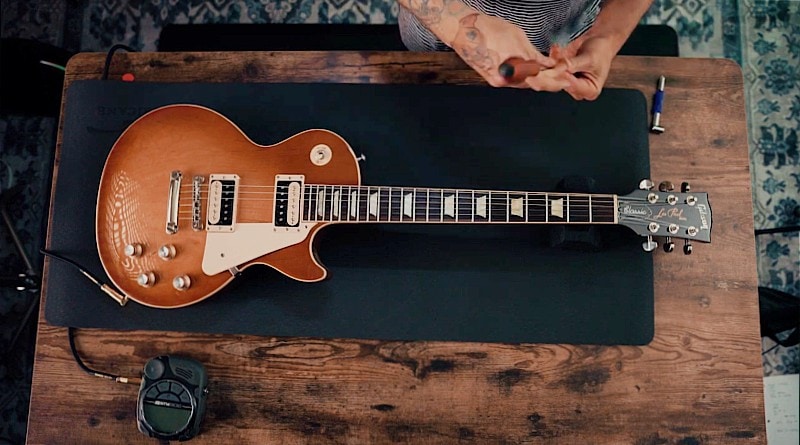The Les Paul may have gone through some changes over the years, but its iconic silhouette is undoubtedly one of the most recognizable designs, not just in music, but in pop culture as a whole.
Because of its popularity, it’s also one of the most imitated guitars on the market. From guitars in the style of it, inspired by it, or even just straight-up copying it, there are many types of Les Paul to suit all different players. In this KillerGuitarRigs guide, we’ll be taking a look at some of the best Les Paul-style guitars on the market.
During the reviews we were looking for looks and appearance, build quality, tones, and tuning stability. To keep things consistent, we ran every guitar through the same amp, in this case a Boss Katana 50. Keep on reading to find out what we learned about these great guitars.
Read more about our review process.
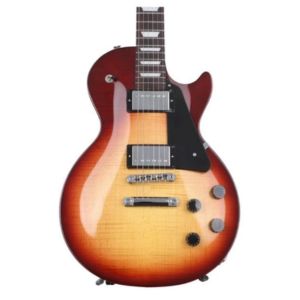
Gibson Les Paul Studio Plus
Features: Stunning AA flamed top, Coil splitting humbuckers, Weight relieved body
Benefits: Comfortable to hold, wide range of tones, Superb playability
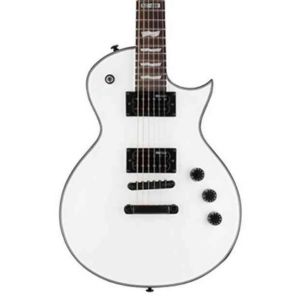
ESP LTD EC-256
Features: Rosewood fretboard, Set neck construction, Extra jumbo frets
Benefits: Huge tone, Superb build quality, responsive feel
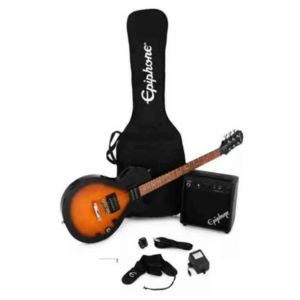
Epiphone Les Paul Player Pack
Features: Amp & accessory pack, Rosewood fretboard, Dual humbucking pickups
Benefits: Real Les Paul Looks and tone, Forgiving playability, Excellent value for money
Contents
Our Top 3
The ESP LTD EC-256 was our Top Pick. It offers a great blend of price and performance, with handsome looks, killer tones, and solid build quality.
Our Best Budget winner was the Epiphone Les Paul Player Pack – a great turnkey bundle with an Epiphone Les Paul Special II at its heart. We loved the guitar and finding such a great bundle with it at such a low price is incredible value.
If you’re working with a bigger budget and you’re looking for the best of the best, the Gibson Les Paul Studio is a no-brainer for our Editor’s Choice. As the guitar that inspired all of the others on this list, it’s almost certainly the one you want.
Individual Reviews

ESP LTD EC-256
Metal attitude with truly surprising versatility.
A great choice for those looking to explore the heavier side of the Les Paul. This model offers the classic LP shape with edgier styling and a neck that’s purpose built for shredding.
The well-packaged ESP LTD EC-256 took quite a while to unwrap, which is in our minds a great sign that care was taken to ensure the guitar gets to the buyer in top condition – and we weren’t wrong! When we finally got to the guitar, we found a gorgeous “Snow White” finish on this edgy Les Paul-style guitar.
Just like a Gibson Les Paul, it had a 24.75” scale length, so the feel was quite similar. It had a 3-piece set mahogany neck, and 22 well-finished, extra jumbo frets topping off the jatoba fretboard, a wood we’ve really come to like for both its feel and looks. The “Thin U” neck profile was extremely comfortable and lightning fast – perfect for metal and rock.
The body was all mahogany, and unlike a Gibson or Epiphone, it had no maple cap, which is probably how they managed to keep the weight down. The top had a slight arch to it, which really helped the ergonomics, giving us a comfortable place to rest the strumming hand, no matter where we placed it.
Like any good LP-style guitar, it was loaded with a pair of ESP humbuckers, an LH-150N in the neck, and an LH-150B in the bridge. The neck position gave us great warmth and a really smooth tone. In the lead setting, we got searing top end that responded brilliantly to high gain.
Adding to the versatility of this LTD was the coil-tapping function, which let us split the humbuckers for a single-coil tone by pulling out on the tone knob.
The black hardware looked awesome and performed just as well. The keystone-style machine heads did a fantastic job with tuning stability, even in drop tunings. Intonation was dead on and the action was just about perfect right out of the box.
Verdict: The ESP LTD EC-256 is a solid all-round choice if you’re looking for a Les Paul-style guitar. It offers top-quality construction, great hardware and electronics, and fantastic playability. ESP guitars are mostly known for metal, but this model was surprisingly versatile and gave us great warmth and even some nice cleans thanks to the coil-splitting, as well as high gain grunt.

Epiphone Les Paul Player Pack
The authentic Les Paul experience at a fraction of the cost.
With this pack you’re getting an authentic licensed Les Paul offering the tones and playability you’d expect, while also including an amp and a number of other great accessories to get you started.
This Epiphone Les Paul Player Pack was really presented well in its bundle box. Everything was nicely separated and, despite there being an amp and a guitar as well as numerous accessories, everything was in perfect condition on arrival. We were sent the Vintage Sunburst-finish model, but it’s also available in ebony if sunburst isn’t your thing.
The guitar that comes with the bundle is an Epiphone Les Paul Special II, an entry-level, licensed copy of the Gibson Les Paul Special. So unlike the non-Epiphone/Gibson models on this list, you’ll actually see “Les Paul Model” on the headstock.
This is a slab body model, so like the ESP, there’s no maple cap, which does keep the weight lower. The scale length was correct to the style at 24.75”.
One of the ways Epiphone kept the cost down on this LP was by using a bolt-on neck, rather than the traditional set neck. We had no complaints about how it played or the overall feel. In fact, given that this model is typically marketed towards beginners, it actually makes the whole guitar a little less fragile.
The neck was made from maple and, surprisingly for a budget model, it even had a rosewood fretboard. The fretboard felt great and looked better than the typical laurel you’d see at this price point. We liked that the frets were well-finished, without any kind of burrs or sharp edges. The crowns weren’t highly polished, but they weren’t too scratchy, either.
It had an alder body, which gave it a nice resonance and kept tones a little brighter and snappier than you’d find on an all-mahogany body LP. This design is quite clever, as it manages to come close to the kind of tones you’d get from a maple-capped model, without the weight and added expense.
As for electronics, it was loaded with a 650T humbucker in the neck and a 700T humbucker in the bridge. They were open-coil design, which for inexpensive pickups, gave us a nice, broad range of tones. They did cleans well, and handled high gain without muddiness.
To give you a little more info on the rest of the bundle, it came with a 10-watt practice amp, a gig bag, a tuner, instrument cable, and even a strap, giving you everything you need to get playing all in one box.
Verdict: The Epiphone Les Paul Player Pack offers budget-conscious players the opportunity to get their hands on a licensed Les Paul Model at an outrageously low price. The guitar itself is really well made, and has all of the classic Les Paul features, from the body shape down to the rock-ready pickups.
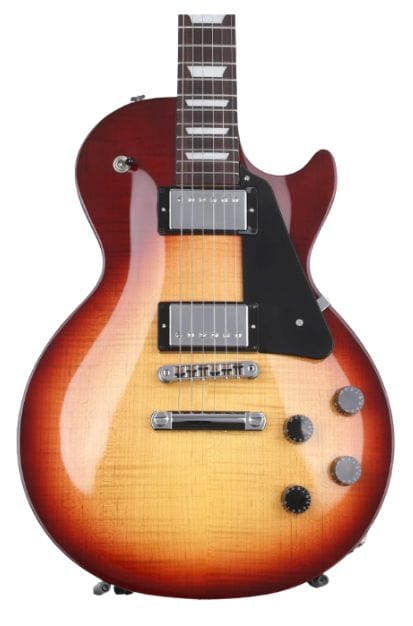
Gibson Les Paul Studio
The best value Gibson Les Paul, bar none.
You’ll get the ultimate in build quality and high end fit and finish with this model from Gibson. Tones are incredible, and thanks to the standard PLEK finishing, playability is beyond compare.
There’s no way we could compile a list of the best Les Paul-style guitars without including the real McCoy, the Gibson Les Paul Studio. No matter how many times you do it, there’s something special about unboxing a Gibson, so the whole experience was quite exciting. Inside the outer box, we found a plush, well-padded Gibson-branded gig bag and inside was a beautiful Les Paul Studio.
The set mahogany neck had a SlimTaper profile, making it extremely comfortable for almost all players and giving it lightning speed at both ends. The rosewood fretboard was absolutely perfect; properly hydrated with great feel and stunning looks.
We were delighted to see the Studio was PLEK’d right from the factory, a service that can cost as much as $300 by itself (and presents a clear upgrade from the Epiphone version of the Studio). The results were noticeable, with some of the best out-of-the-box fretwork we’ve ever encountered.
The weight-relieved body was mahogany, and it had a solid flamed maple cap, the classic Les Paul recipe. Despite the weight relief, it still rang out for days and the grain of the maple peering through the translucent Red Wine tint looked amazing. Being a studio model, it had a proper carved top, giving it classic looks and great playability.
Interestingly, it featured coil-splitting pickups, giving it a whole extra bank of single-coil quack on top of the fat, growling humbucker tones from the Gibson 490R in the neck and Gibson 498T in the bridge position. Even without the coil-splitting, this Studio handled practically every genre with ease, but the extra versatility made this guitar a real weapon.
Tuning stability was fantastic and the chrome Grover tuners turned as smoothly as you’d expect. We loved the action right out of the box and thanks to the PLEKing, the intonation was perfect.
Verdict: While it’s notably more expensive than the other models on test, if you have the means to go for a Gibson Les Paul Studio, we highly recommend doing so. The fit and finish were absolutely phenomenal and the nitro lacquer will age beautifully over time. We loved how it sounded, with glassy cleans and aggressive punch when played with high gain. When it comes to Les Paul-style guitars, you can’t really do much better than an actual Paul.
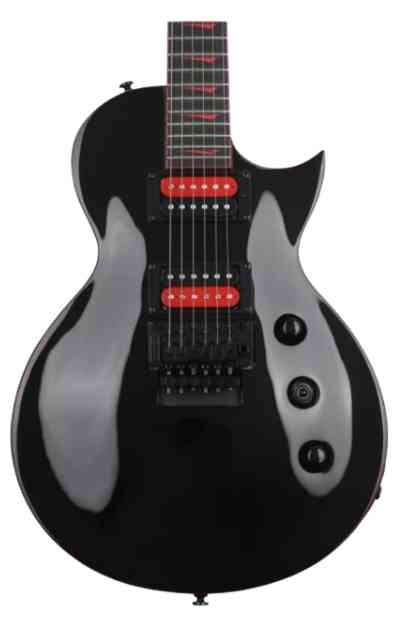
Kramer Assault 220
A hard hitting Les Paul style guitar with close ties to the original Gibson.
This is another great option for fans of faster playing guitars. The neck is designed for speed, and the overall design is packed with heavy metal attitude. The alnico pickups are fantastic, and the parallel/series switching provides an entirely new range of tones not found on other LP style guitars.
We opened up the Kramer Assault 220 to find a great-looking LP-style guitar just dripping with attitude. Our test model was finished in a stunning gloss black with bright red binding, inlay and pickups, all of which really set off the look.
While you won’t see Gibson branding or the words “Les Paul” anywhere on this guitar, remember that Kramer is a division of the Gibson Guitar Corporation, so it’s close to being a licensed replica, rather than just an LP-style model.
The neck was a Speed SlimTaper C, which is Gibson’s fastest profile. It was slick and felt great in the hand. Beginners will find that it’s comfortable, and more advanced guitarists will love the fast play it affords. Like the Les Paul Studio we reviewed, it also had a rosewood fretboard, although in this case it had been stained to appear darker.
In a nod to its Gibson roots, this Kramer had a mahogany body and even a carved maple cap. The cutaway on the treble bout was super aggressive, which not only gave it a meaner look, but also provided even better access to the upper frets than you’d find on a standard LP-style guitar.
We really liked the pickups Kramer equipped the Assault 220 with. It had a pair of hot alnico V humbuckers that really ripped with high gain settings on the amp. This was another guitar with a push/pull tone knob, but rather than splitting the coils, it allows you to switch between parallel and series on the neck pickup. In series, we got thick, beefy tones. In parallel mode, it cleaned up with a trebly, almost glassy sound.
We loved the idea of having the Floyd Rose trem system, but ultimately it ended up being a bit of a hindrance. It was a licensed FR system, and wasn’t quite as high-quality as an authentic US-made model. We found the fine-tuning knobs were quite difficult to use, and while it was stable after getting to pitch, the whole tuning process was more arduous than we hoped it would be.
Verdict: The Kramer Assault 220 is another great metal-focused LP-style guitar. The Floyd Rose is pretty uncommon on this style, but if it’s a feature you’re into, this is the most affordable way to get into divebombs on a Les. We loved the finish (especially the red accents) and the overall feel was great. Tonally, it was pretty versatile thanks to the parallel/series pull/push knob, and we couldn’t have asked for a more comfortable guitar.
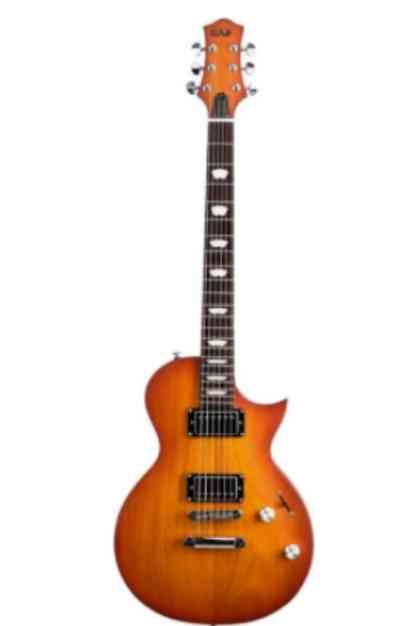
Eart Studio EGLP-610
All the basics done right on this homage to the classic Les Paul design.
This guitar might be not be from a mainstream brand, but it’s absolutely built like it came from one. It features high end hardware, including stainless steel frets, and offers unheard of playability for this price range.
We’d heard great things about Eart Guitars, so we were pretty excited to get the chance to try out this Eart Studio EGLP-610. It’s quite obviously made in the same mold as the Les Paul, although not so much that you’d call it a clone.
After unboxing, we realized we’d been sent the Honey Satin Tea finish. It was well applied, but perhaps a little too bland as a color, although this is entirely personal. The body was made from 2 pieces of okume, which is a more sustainable and affordable mahogany alternative. The grain was extremely similar to that which you’d find on a mahogany model, and was similar weight-wise as well.
The back of the body was actually upgraded from the classic Les Paul design in that it had comfort contouring under the arm. This was a great touch, and it’s something not often seen on this style of guitar.
It did have a set neck, which was also made from okume. The profile tapered from a U at the lower end to a slim C at the high frets. It felt good and played nicely, but it wasn’t quite as fast-playing as the likes of the Kramer or the LTD. One of the things that has made Eart guitars such a cult phenomenon are their frets. For the price, we thought the frets were absolutely fantastic and, while not on the same level as the PLEK’d Gibson, they weren’t a million miles behind.
As for pickups, it had a pair of quality Alnico II humbuckers. We didn’t get much information about the pickups themselves, but upon playing them, we found that the neck pickup had great warmth and tight mid focus, but the bridge lost a little bit of clarity with high gain. Overall, they weren’t bad, but they weren’t this guitar’s strongest point.
Fortunately, it held tune well. The hardware was all surprisingly good quality, considering the relative obscurity of the brand, and we’d have no problems trusting it during a gig.
Verdict: The Eart Studio EGLP-610 had come highly recommended, and we were glad we got the chance to try it. High points were definitely the overall build quality and the high standard of fretwork, something not often found at this price point. Tones were generally good, but as mentioned, it did tend to lose a little clarity with high gain on the bridge setting.
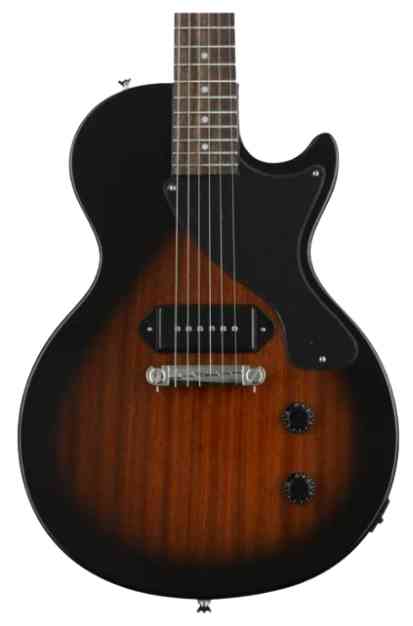
Epiphone Les Paul Jr
The student guitar turned punk icon.
With this Epiphone you’ll be getting the next best thing to a real Gibson LP Jr at a quarter of the price. It’s fantastically made, and has all the growl and bite of the original. Even though it isn’t cheap, it’s still a bargain.
The Epiphone Les Paul Jr is an almost exact replica of the Gibson model of the same name. A guitar that started life as a cheap beginner electric guitar, but thanks to its simplicity and affordability, became legendary in punk and other alternative genres.
This model was from the “Inspired by Gibson” range, which are the closest thing you can get to a real-deal Gibson without having to spend Gibson money. After first catching a glimpse, we really loved the Tobacco Burst finish. It was dark and rich, and the grain showed through beautifully.
The body was all mahogany, with a classic LP single-cut silhouette. We found it to be exceptionally comfortable to hold, especially while standing. The neck was also crafted from solid mahogany, but that’s where its similarities to the other models ended. This Jr had a vintage ‘50s profile, making it one of the chunkiest you’ll find on any guitar anywhere. It does take some getting used to after playing around with shredders, but the fact remains that fat necks aren’t for everybody.
It had an Indian laurel fretboard, a wood found on most Epiphone models these days. This doesn’t have quite the same feel and look as rosewood, but given the sustainability issues surrounding the more exotic wood, the laurel works just fine. It felt good under the fingers, although the pores were a little too open for our tastes.
Where the Les Paul Jr is most noticeably different to the carved-top models is in the pickup arrangement. Rather than a pair of humbuckers, it has a single P90 mounted by the bridge. By definition, it does lose some of the versatility you get with 2 pups, but we absolutely loved the tones we got out of it. With the tone and volume knobs maxed, it was snarling and perfect for heavier styles. With a rollback on the tone, we got some fantastic blues warmth. Taking the volume down gave us some amazing cleans, too.
Hardware was all great quality, and tuning stability was brilliant out of the box. It was equipped with high-end parts, including a Graphtech TusqXL nut, and even full-size CTS pots.
Verdict: You shouldn’t count out the Epiphone Les Paul Jr if you’re shopping for a Les Paul style instrument. Being one of the most famous variants of the iconic design, the Jr appeals to a whole subset of the LP market, and if snarling tones, a lightweight body, and a chunky neck sound good to you, then you’re going to love this guitar.
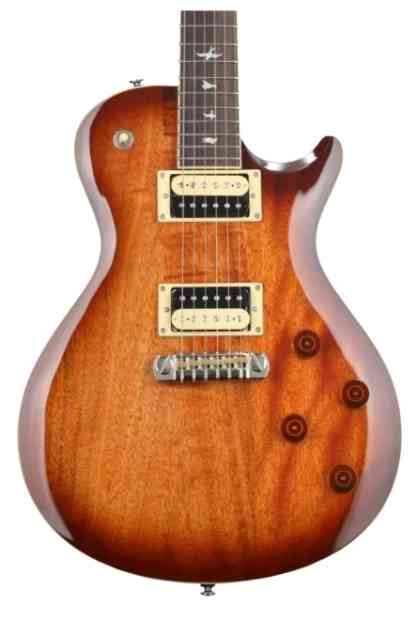
PRS SE Standard 245
Classic Les Paul Styling done the PRS way.
It might be something of a wild card, but this PRS offers a lot of what Les Paul style guitar shoppers want, including a single cut mahogany body, fat humbucker pickups, and a set neck. The fact that it offers a finish comparable to many Gibsons is just the icing on the cake.
PRS Singlecuts often get left out of the Les Paul-Style conversation. They’ve differentiated themselves enough with the body carving that they have almost become their own thing. In reality, though, it’s not hard to see that the design of the PRS SE Standard 245 was clearly lifted from Gibson’s shape.
Inside the box, we found the guitar was cocooned in a really nice backpack-style gig bag. It had plush padding and nice PRS SE branding on the outside. Especially since we weren’t expecting a case of any description, it was a pleasant surprise to get one.
When we removed the guitar from the case, we found ourselves impressed at the quality of the finish. If there’s one thing that PRS does an outstanding job on, it’s colors and finishes, even on their import models. The color was called Tobacco Sunburst, but despite the similarity to the name of the Epiphone Les Paul Jr, it was a much brighter finish.
The mahogany neck was a PRS wide fat profile. It wasn’t as thick as the ’50s vintage on the LP Jr, but it wasn’t too far off. Again, this might make the guitar uncomfortable for those with smaller hands, or those who may be used to fast-playing guitars like the Kramer or LTD. The neck was set into the body, and thanks to the low profile heel, the upper frets were easily accessible.
The pickups were a matched pair of PRS 245 S humbuckers, and we liked them very much. We got glassy cleans on the bridge pickup with a low gain setting on the amp. In the bridge position, we got some rich bluesy tones, with tight mids and a lot of punch when pushed hard. The one position we didn’t much care for was the middle. We found that tones seemed a little washed out at this setting, losing some of the focus we found in abundance at the bridge and neck positions.
The fit and finish were overall great, including the choice of hardware. It had PRS-branded sealed geartuners that did their job very well. They allowed for fine control when tuning, and once we were at pitch, they held strong. This model didn’t have a trem bridge, so the hardtail also no doubt contributed to the solid tuning stability.
Verdict: This isn’t the most obvious choice for an LP-style guitar, but the PRS SE Standard 245 really does make sense. The brand carries almost as much weight as Gibson and the guitar has an unmistakable presence that doesn’t scream “Les Paul copy.” It sounded great, offering versatile tones, and we really loved the overall build quality.
How to Choose The Right Guitar For You
When shopping for a Les Paul-style guitar, there are a few things to be aware of if you’re not overly familiar with these instruments. Keep reading to learn a little more about what to look for.
Body Shape
While there are double-cut Les Pauls available, the classic shape is the single cut. This cutaway gives access to the upper frets and, because the upper bout is still whole, there is more mass to the body, resulting in greater sustain and resonance.
Set Neck
With a few exceptions, Les Paul-style guitars will almost always have a set neck. That is, a neck glued into the locket rather than bolted onto the body. It is said this improves the overall strength of the guitar and allows more of the vibration to pass from the strings into the body, resulting in better sustain. There are some models with bolt-on necks, but they do tend to be the more affordable, beginner-oriented guitars.
Pickups
The vast majority of Les Pauls and Les Paul-style guitars will have 2 humbuckers and a 3-way selector switch. Models with 1 or 2 P90 pickups are also common, but single-coils are almost unheard of. The use of humbuckers gives these guitars their signature fat tones, and in the case of the P90s, an unmistakable growl.
Fixed Bridge
The standard Les Paul configuration calls for a Tune-o-matic bridge with a stop bar tailpiece, but other brands have taken creative liberties with their designs. In some cases, floating tremolo bridges have been installed, or even Floyd Rose systems with locking nuts.
Final Thoughts
Les Pauls are some of our favorite guitars here at KGR, and it’s easy to see why so many brands have tried to copy the formula. We hope you found this guide useful. Let’s bring things to a close with a recap of our top choices.
If you’re looking for a blend of affordability and high performance, the ESP LTD EC-256 is a great choice. Budget-conscious shoppers should look at the Epiphone Les Paul Player Pack. Those who want the very best and don’t mind spending to get it should consider going for a Gibson Les Paul Studio.
Check out these other articles you might like:

